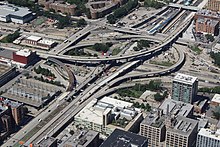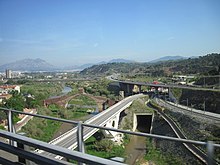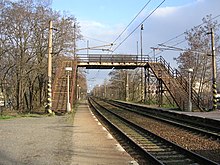
Back تقاطعات على مستويات مختلفة Arabic উচ্চতা পৃথকীকরণ Bengali/Bangla Pas a desnivell Catalan Höhenfreiheit German Paso a desnivel Spanish تقاطع غیرهمسطح Persian Croisement dénivelé French 立体交差 Japanese Ongelijkvloerse kruising Dutch Skrzyżowanie wielopoziomowe Polish




In civil engineering (more specifically highway engineering), grade separation is a method of aligning a junction of two or more surface transport axes at different heights (grades) so that they will not disrupt the traffic flow on other transit routes when they cross each other. The composition of such transport axes does not have to be uniform; it can consist of a mixture of roads, footpaths, railways, canals, or airport runways. Bridges (or overpasses, also called flyovers), tunnels (or underpasses), or a combination of both can be built at a junction to achieve the needed grade separation.
In North America, a grade-separated junction may be referred to as a grade separation[1][2] or as an interchange – in contrast with an intersection, at-grade, a diamond crossing or a level crossing, which are not grade-separated.
- ^ City of Eureka Municipal Code 71.85 Archived 2012-02-12 at the Wayback Machine (California, US)
- ^ Henry K. Evans (1950). "Read the ebook Traffic engineering handbook by Institute of Traffic Engineers". ENGINEERING HANDBOOK, Second Edition 1950. New Haven, Connecticut: Institute of Traffic Engineers. Archived from the original on 2018-10-13. Retrieved 2010-10-09.
© MMXXIII Rich X Search. We shall prevail. All rights reserved. Rich X Search